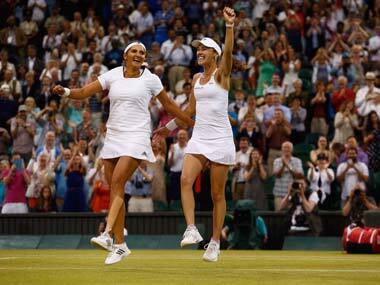The pure ecstasy was palpable. Racquets were thrown. Several manic jumps in the air were made. Then they wrapped each other in a big bear hug, one filled with so much joy, raw emotion and accomplishment, it propelled the normally staid centre court crowd at Wimbledon to rise and roar in appreciation. India’s Sania Mirza and Switzerland’s Martina Hingis had won their first major as a pairing in women’s doubles, somehow overcoming a 5-2 hole in the deciding third set to beat Russian duo Ekaterina Makarova and Elena Vesnina 5-7, 7-6, 7-5. After a disappointing French Open campaign, the number one seeds had won at Wimbledon, tennis’ most iconic event. The deciding set was an epic struggle, with Mirza and Hingis trailing for much of the match and struggling to dictate against the world’s number two ranked pair. They fought back with resilience and eventually their class told during an incredible last five games when the pair’s shot-making simultaneously caught fire and magical strokes continually ensued. [caption id=“attachment_2338816” align=“alignleft” width=“380”]  Sania Mirza and Martina Hingis celebrate winning Wimbledon. Getty Sports[/caption] Doubles can often feel like tennis’ forgotten sibling, with singles hogging nearly all of the mainstream spotlight, but the format is at its very best when a pair’s contrasting strengths unite to unleash an irresistible and unstoppable package. Hingis and Mirza have shown glimpses of their potential since pairing earlier this year but their eclectic talents magically synchronised, like never before, right when they needed to summon something special. It was delightful to watch. They complement each other perfectly; Hingis is adept with the backhand juxtaposing nicely with Mirza’s lethal forehand. With her forceful groundstrokes, Mirza sets up points while Hingis – highly skilled at the net – finishes them off. Hingis is sublime at the net and may still be the best player in the world at reading the play. Her perfectly executed lobs continually baffle opponents. Some believe Hingis could still be an elite player if she competed in singles, but in reality Hingis would be unlikely to progress into the second week. Her serve is timid and often her groundstrokes lack venom. Sometimes she struggles to move around the court freely, and despite her youthful looks, it is a timely reminder that Hingis is nearly 35 years old and has a history of ankle injuries. But those deficiencies, which would be cruelly exposed by the likes of Serena Williams in singles, can be covered by the right partner in doubles. And Mirza’s high-octane game has been the necessary tonic for Hingis’ best traits to be more effective. When in sync, the pair are the perfect foil for each other. Hingis is ultra-consistent albeit not always penetrative; Mirza’s high powered game is frenetic albeit volatile. Most importantly, they seem to genuinely like playing with each other. Hingis and Mirza were a vivacious combination throughout, even when they were just two points from a heartbreaking defeat. They never sulked at each other, or bickered aloud. Instead, their interaction was marked by mirth. Hingis and Mirza appeared to be having a really good time, and that measured approach was key in their ability to not get frazzled or overawed in those perilous moments during the final. It was a special victory for vastly different reasons for the duo. Hingis never expected to be playing professionally again. After all, she was playing in the legends circuit just a few years ago. She last won a Wimbledon crown back in 1998, and Hingis aptly said post match that that victory “feels like it was in another life”. She was the ultimate tennis prodigy, destined for greatness when named after tennis icon Martina Navratilova. Despite all her success - she spent 209 as world number one - Hingis was often petulant and brooding – both on and off the court. The pressures at such a young age seemed to overwhelm. She retired at age 22, and despite a brief comeback in the mid-2000s, Hingis’ career seemed to sadly end prematurely. Now, during her latest surprising comeback, Hingis seems more at peace and looks like she is playing for the sheer love of the game. For Mirza, the number one ranked women’s doubles player - first Indian to achieve it - winning Wimbledon gave her her first women’s doubles grand slam trophy. Athletes generally admit the first breakthrough is their most special. It sure was special seeing Mirza basking in the realisation that all the years of sacrifice, toil, ups and downs and criticisms was worth it. She’ll forever be remembered as a Wimbledon champion now. Mirza also hopes her victory fuels a new generation of young tennis players in India. “I hope it inspires a lot of girls and makes them believe they can be grand slam champions too,” she said after the final. The duo might not share a long union as Hingis has hinted she may call it quits after the 2016 Rio Olympics. But they won’t be worrying about the future too much. Right now, Hingis and Mirza will be savouring their victory and cherishing being etched in Wimbledon folklore. It doesn’t get better than that.
Hingis and Mirza have shown glimpses of their potential since pairing earlier this year but their eclectic talents magically synchronised like never before.
Advertisement
End of Article


)

)
)
)
)
)
)
)
)



